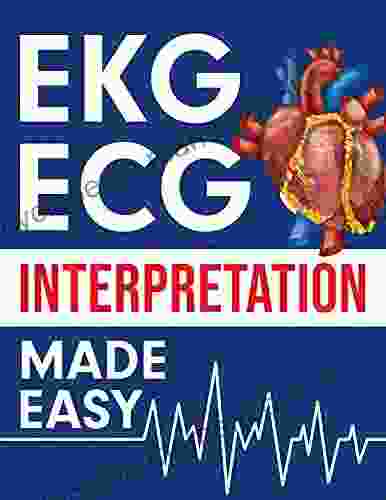EKG ECG Interpretation Made Easy: An Illustrated Guide for Healthcare Professionals

An electrocardiogram (EKG or ECG) is a graphical representation of the electrical activity of the heart. It is a valuable tool for diagnosing and managing a wide range of heart conditions, including arrhythmias, myocardial infarction, and heart failure.
However, interpreting EKGs and ECGs can be a challenging task, even for experienced healthcare professionals. This guide will provide you with a comprehensive overview of EKG and ECG interpretation, and will help you to develop the skills you need to interpret these recordings accurately and confidently.
Before we begin interpreting EKGs and ECGs, it is important to understand some basic concepts.
4.5 out of 5
| Language | : | English |
| File size | : | 44720 KB |
| Text-to-Speech | : | Enabled |
| Screen Reader | : | Supported |
| Enhanced typesetting | : | Enabled |
| Print length | : | 234 pages |
| Lending | : | Enabled |
- The heart's electrical system: The heart's electrical system is responsible for generating and conducting the electrical impulses that cause the heart to contract. The electrical impulses originate in the sinoatrial node (SA node),which is located in the right atrium. The SA node sends the electrical impulses to the atrioventricular node (AV node),which is located between the atria and the ventricles. The AV node delays the electrical impulses slightly, which allows the atria to fill with blood before the ventricles contract. The electrical impulses then travel down the bundle of His, which is a group of fibers that connect the AV node to the ventricles. The bundle of His divides into the left and right bundle branches, which carry the electrical impulses to the left and right ventricles.
- The EKG and ECG: An EKG or ECG is a graphical representation of the electrical activity of the heart. The EKG is recorded using a series of electrodes that are placed on the skin of the chest, arms, and legs. The electrodes measure the electrical impulses generated by the heart and send them to an EKG or ECG machine. The EKG or ECG machine then records the electrical impulses on a piece of paper or on a computer screen.
- The EKG and ECG waves: The EKG or ECG recording consists of a series of waves. The waves are named P, Q, R, S, and T. The P wave represents the electrical activity of the atria. The QRS complex represents the electrical activity of the ventricles. The T wave represents the electrical activity of the ventricles repolarizing.
The interpretation of EKGs and ECGs involves identifying the different waves and intervals on the recording and determining their significance.
- The P wave: The P wave is the first wave on the EKG or ECG recording. It represents the electrical activity of the atria. The P wave is normally upright in the leads that are placed on the chest and the left arm. It is normally inverted in the leads that are placed on the right arm and the right leg.
- The QRS complex: The QRS complex is the second wave on the EKG or ECG recording. It represents the electrical activity of the ventricles. The QRS complex is normally upright in the leads that are placed on the chest and the left arm. It is normally inverted in the leads that are placed on the right arm and the right leg.
- The T wave: The T wave is the third wave on the EKG or ECG recording. It represents the electrical activity of the ventricles repolarizing. The T wave is normally upright in the leads that are placed on the chest and the left arm. It is normally inverted in the leads that are placed on the right arm and the right leg.
- The intervals: The intervals on the EKG or ECG recording are used to measure the duration of the electrical activity of the heart. The intervals are named PR interval, QRS interval, and QT interval. The PR interval is the time from the beginning of the P wave to the beginning of the QRS complex. The QRS interval is the time from the beginning of the QRS complex to the end of the QRS complex. The QT interval is the time from the beginning of the QRS complex to the end of the T wave.
Rhythm analysis is the process of determining the type of heart rhythm that is present on the EKG or ECG recording. The heart rhythm is classified as either sinus rhythm, atrial rhythm, or ventricular rhythm.
- Sinus rhythm: Sinus rhythm is the normal heart rhythm. It is characterized by a regular, even pulse rate. The P waves are upright in the leads that are placed on the chest and the left arm. The QRS complexes are upright in the leads that are placed on the chest and the left arm. The T waves are upright in the leads that are placed on the chest and the left arm.
- Atrial rhythm: Atrial rhythm is a type of heart rhythm that is characterized by the presence of P waves that are not followed by QRS complexes. Atrial rhythm can be caused by a variety of conditions, including atrial fibrillation and atrial flutter.
- Ventricular rhythm: Ventricular rhythm is a type of heart rhythm that is characterized by the presence of QRS complexes that are not preceded by P waves. Ventricular rhythm can be caused by a variety of conditions, including ventricular tachycardia and ventricular fibrillation.
Arrhythmia interpretation is the process of identifying and classifying arrhythmias on the EKG or ECG recording. Arrhythmias are abnormal heart rhythms that can be caused by a variety of conditions.
The most common types of arrhythmias include:
- Premature atrial contractions (PACs): PACs are premature beats that originate in the atria. PACs are usually benign, but they can sometimes cause symptoms such as palpitations or chest pain.
- Premature ventricular contractions (PVCs): PVCs are premature beats that originate in the ventricles. PVCs are usually benign, but they can sometimes cause symptoms such as palpitations or chest pain.
- Atrial fibrillation (AFib): AFib is a type of arrhythmia that is characterized by the presence of irregular, rapid P waves. AFib can increase the risk of stroke and heart failure.
- Atrial flutter: Atrial flutter is a type of arrhythmia that is characterized by the presence of regular, rapid P waves. Atrial flutter can increase the risk of stroke and heart failure.
- Ventricular tachycardia (VT): VT is a type of arrhythmia that is characterized by the presence of regular, rapid QRS complexes. VT can be life-threatening if it is not treated promptly.
- Ventricular fibrillation (VF): VF is a type of arrhythmia that is characterized by the presence of irregular, rapid QRS complexes. VF is a life-threatening arrhythmia that can lead to sudden cardiac death.
The best way to improve your skills in EKG and ECG interpretation is to practice regularly. There are a number of resources available online and in libraries that can provide you with practice EKGs and ECGs. You can also take an EKG or ECG course or workshop to learn more about the basics of EKG and ECG interpretation.
EKG and ECG interpretation is a valuable skill for healthcare professionals. With practice, you can develop the skills you need to interpret EKGs and ECGs accurately and confidently. This guide has provided you with a comprehensive overview of EKG and ECG interpretation, and has introduced you to the basic concepts of EKG and ECG interpretation. By continuing to practice and learn, you can become proficient in EKG and ECG interpretation and provide better care for your patients.
4.5 out of 5
| Language | : | English |
| File size | : | 44720 KB |
| Text-to-Speech | : | Enabled |
| Screen Reader | : | Supported |
| Enhanced typesetting | : | Enabled |
| Print length | : | 234 pages |
| Lending | : | Enabled |
Do you want to contribute by writing guest posts on this blog?
Please contact us and send us a resume of previous articles that you have written.
 Top Book
Top Book Novel
Novel Fiction
Fiction Nonfiction
Nonfiction Literature
Literature Paperback
Paperback Hardcover
Hardcover E-book
E-book Audiobook
Audiobook Bestseller
Bestseller Classic
Classic Mystery
Mystery Thriller
Thriller Romance
Romance Fantasy
Fantasy Science Fiction
Science Fiction Biography
Biography Memoir
Memoir Autobiography
Autobiography Poetry
Poetry Drama
Drama Historical Fiction
Historical Fiction Self-help
Self-help Young Adult
Young Adult Childrens Books
Childrens Books Graphic Novel
Graphic Novel Anthology
Anthology Series
Series Encyclopedia
Encyclopedia Reference
Reference Guidebook
Guidebook Textbook
Textbook Workbook
Workbook Journal
Journal Diary
Diary Manuscript
Manuscript Folio
Folio Pulp Fiction
Pulp Fiction Short Stories
Short Stories Fairy Tales
Fairy Tales Fables
Fables Mythology
Mythology Philosophy
Philosophy Religion
Religion Spirituality
Spirituality Essays
Essays Critique
Critique Commentary
Commentary Glossary
Glossary Bibliography
Bibliography Index
Index Table of Contents
Table of Contents Preface
Preface Introduction
Introduction Foreword
Foreword Afterword
Afterword Appendices
Appendices Annotations
Annotations Footnotes
Footnotes Epilogue
Epilogue Prologue
Prologue Patrick Johns
Patrick Johns William Shakespeare
William Shakespeare Andrew K Milton
Andrew K Milton Tracy Lee Heavner
Tracy Lee Heavner Alfie Kohn
Alfie Kohn Joyce Akesson
Joyce Akesson Griff Hosker
Griff Hosker Daniel Defoe
Daniel Defoe Carolyn Chen
Carolyn Chen Jonathan Deutsch
Jonathan Deutsch Josephine Anderson
Josephine Anderson Meg Belviso
Meg Belviso Elijah Devivo
Elijah Devivo Ashley Lane
Ashley Lane Richard A Quantz
Richard A Quantz Blaze Ward
Blaze Ward Susan Orlean
Susan Orlean Cigdem Knebel
Cigdem Knebel Carissa Andrews
Carissa Andrews Jill Scott
Jill Scott
Light bulbAdvertise smarter! Our strategic ad space ensures maximum exposure. Reserve your spot today!

 Joel MitchellThe Boy Scout of Campfire Stories: Collector's Edition for the Children's...
Joel MitchellThe Boy Scout of Campfire Stories: Collector's Edition for the Children's...
 Dwight BellA Comprehensive Guide to Cultivating the Family Enterprise: Nurturing Legacy,...
Dwight BellA Comprehensive Guide to Cultivating the Family Enterprise: Nurturing Legacy,... Dawson ReedFollow ·16.7k
Dawson ReedFollow ·16.7k Christopher WoodsFollow ·6.7k
Christopher WoodsFollow ·6.7k Ted SimmonsFollow ·11.4k
Ted SimmonsFollow ·11.4k Brady MitchellFollow ·10.2k
Brady MitchellFollow ·10.2k David PetersonFollow ·13.1k
David PetersonFollow ·13.1k Darren BlairFollow ·8.4k
Darren BlairFollow ·8.4k Lord ByronFollow ·7.7k
Lord ByronFollow ·7.7k Ernest ClineFollow ·4.9k
Ernest ClineFollow ·4.9k

 Fabian Mitchell
Fabian MitchellTen Thousand Spirals: Leccion Inagural Del Curso...
Ten Thousand...

 Howard Blair
Howard BlairThe Captivating Collection of High School Romance Poetry
Love's First...
4.5 out of 5
| Language | : | English |
| File size | : | 44720 KB |
| Text-to-Speech | : | Enabled |
| Screen Reader | : | Supported |
| Enhanced typesetting | : | Enabled |
| Print length | : | 234 pages |
| Lending | : | Enabled |















